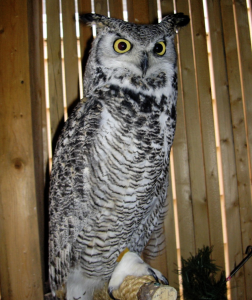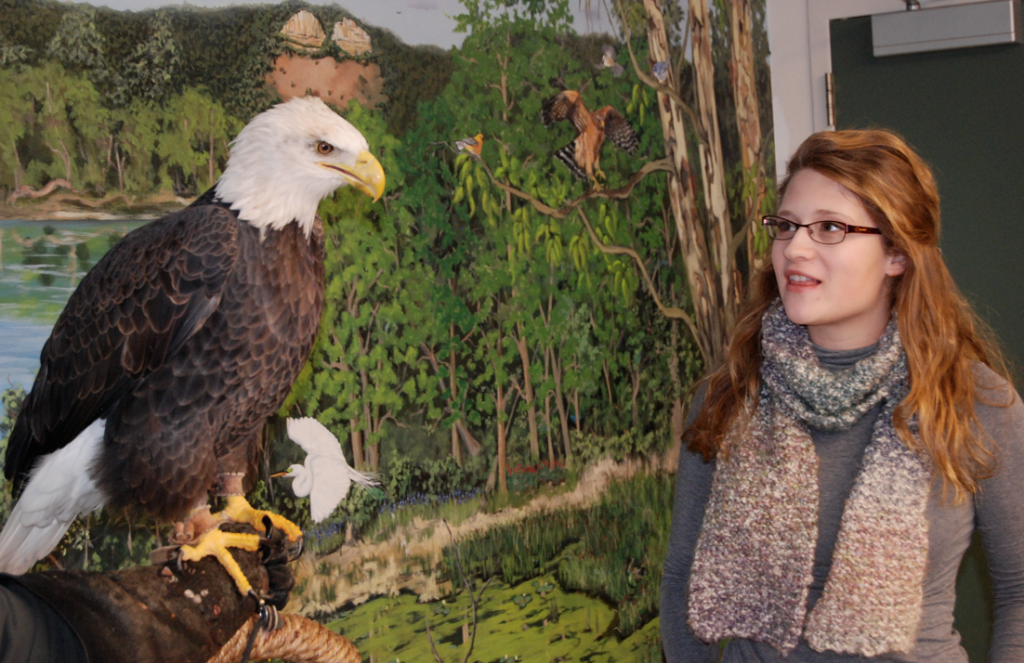Posted 12:16 p.m. Tuesday, July 22, 2014

Researchers in UW-L’s rex Lab are uncovering more about dinosaur biomechanics.
 UW-L student Lauren Schultz is a biology major and a pre-med, chemistry and Spanish minor. Here she is comparing dinosaur and crocodile skull models with paleontologist Eric Snively.[/caption]
By Patrick DeFlorin, student staff writer
Humans outgrow their baby teeth, snakes outgrow their skins, crabs outgrow their shells, and now, explains Eric Snivley, UW-L professor of Biology, we are almost certain that juvenile carnivorous dinosaurs had feathers that some outgrew.
"It ruins the perception you had as a kid," says Lauren Schultz, a student researcher in Snively's lab. "You put feathers on them and they are just not scary anymore. They look like these huge chickens. It's ridiculous. It makes it real."
Snively and his team of student researchers in UW-L’s rex Lab are uncovering more about what dinosaurs were really like.
But instead of studying dinosaur plumage, they aim to uncover more details about dinosaur feeding patterns. The key to their research is bone density, and in the case of feeding pattern, skull density.
Schultz uses software for CT scanners like those used for medical diagnostics to determine dinosaur skull density. The CT scanners create a series of cross-section images of the bone that Schultz then coalesces into a 3D model. The result is an image with Rorschach-meets-Doppler radar coloration.
"I've gotten a lot better at reading CTs," says Schultz, pointing to a red region that indicates high density on a model of a crocodile skull she made.
[caption id="attachment_35418" align="alignleft" width="350"]
UW-L student Lauren Schultz is a biology major and a pre-med, chemistry and Spanish minor. Here she is comparing dinosaur and crocodile skull models with paleontologist Eric Snively.[/caption]
By Patrick DeFlorin, student staff writer
Humans outgrow their baby teeth, snakes outgrow their skins, crabs outgrow their shells, and now, explains Eric Snivley, UW-L professor of Biology, we are almost certain that juvenile carnivorous dinosaurs had feathers that some outgrew.
"It ruins the perception you had as a kid," says Lauren Schultz, a student researcher in Snively's lab. "You put feathers on them and they are just not scary anymore. They look like these huge chickens. It's ridiculous. It makes it real."
Snively and his team of student researchers in UW-L’s rex Lab are uncovering more about what dinosaurs were really like.
But instead of studying dinosaur plumage, they aim to uncover more details about dinosaur feeding patterns. The key to their research is bone density, and in the case of feeding pattern, skull density.
Schultz uses software for CT scanners like those used for medical diagnostics to determine dinosaur skull density. The CT scanners create a series of cross-section images of the bone that Schultz then coalesces into a 3D model. The result is an image with Rorschach-meets-Doppler radar coloration.
"I've gotten a lot better at reading CTs," says Schultz, pointing to a red region that indicates high density on a model of a crocodile skull she made.
[caption id="attachment_35418" align="alignleft" width="350"] Oberon, the great horned owl, helped researchers in UW-L’s rex Lab figure out how dinosaurs once moved. Researchers observed how he eats. Oberon lives at the Calgary Wildlife Rehabilitation Society.[/caption]
Schultz makes these models for dinosaurs and their modern-day relatives, namely birds and reptiles, and compares them. With knowledge of how birds and reptiles move and behave, she can hypothesize about how a dinosaur once moved. This process involves volleying ideas with Snively and her labmates and helps her hone scientific inquiry skills.
"Lots of students come up with better hypotheses than professors who are often focused on only one aspect of a problem," says Snively.
Students then test these hypotheses with state-of-the-art engineering software that puts the models in motion — a “stress test”. By doing so, students can see how much stress particular dinosaur movements, like tearing flesh from prey, put on specific parts of the bones. If a particular motion results in less stress on the dinosaur bone than would be expected for other similar-sized animals, the researchers can infer that the dinosaur evolved a bone structure optimized for that particular motion.
These movement analyses are cutting-edge; Snively's lab is one of the only groups in the country doing them, which gives students an unparalleled opportunity to do pioneering research.
[caption id="attachment_35399" align="alignright" width="593"]
Oberon, the great horned owl, helped researchers in UW-L’s rex Lab figure out how dinosaurs once moved. Researchers observed how he eats. Oberon lives at the Calgary Wildlife Rehabilitation Society.[/caption]
Schultz makes these models for dinosaurs and their modern-day relatives, namely birds and reptiles, and compares them. With knowledge of how birds and reptiles move and behave, she can hypothesize about how a dinosaur once moved. This process involves volleying ideas with Snively and her labmates and helps her hone scientific inquiry skills.
"Lots of students come up with better hypotheses than professors who are often focused on only one aspect of a problem," says Snively.
Students then test these hypotheses with state-of-the-art engineering software that puts the models in motion — a “stress test”. By doing so, students can see how much stress particular dinosaur movements, like tearing flesh from prey, put on specific parts of the bones. If a particular motion results in less stress on the dinosaur bone than would be expected for other similar-sized animals, the researchers can infer that the dinosaur evolved a bone structure optimized for that particular motion.
These movement analyses are cutting-edge; Snively's lab is one of the only groups in the country doing them, which gives students an unparalleled opportunity to do pioneering research.
[caption id="attachment_35399" align="alignright" width="593"] UW-L student researcher Kari Mosbacher at the National Eagle Center with a bald eagle. Birds are used to help students and staff in UW-L's rex Lab understand how dinosaurs moved.[/caption]
And what are these pioneers discovering? The seminal research in Snively's lab is helping to reshape understanding of dinosaur biomechanics. It turns out T. rex was evolutionarily optimized for striking, crushing and tearing.
"T. rex wins all the time." Snively says with a grin.
T. rex was a juggernaut with a powerful neck and jaws. It could strike its prey like a pigeon pecking at grain on the sidewalk, chomp down, tear flesh like a crocodile thrashing its head from side to side, and escape without having to grapple. This proposed feeding pattern obviates muscular forelimbs for holding down prey and explains the iconic dinky arms of T.rex.
This proposed feeding pattern has also helped differentiate the T. rex eating style from that of carnivorous T. rex predecessors, such as the Allosaurus. Until recently, bones alone have provided insufficient information for scientists to compare dinosaur eating behaviors in detail. Upon employing cutting-edge biomechanical analysis software, however, Snively and colleagues have elucidated that the Allosaurus actually wrenched at its prey much more daintily than T. rex. T. rex fed like a red-tailed hawk or a golden eagle, using its legs minimally and relying mainly on its brawny neck muscles to tear its prey. Allosaurus, on the other hand, had fed more like the American Kestrel in the video below. It pecked at its prey with a scooping motion that allowed it to latch on to its prey and then pulled up with its legs to tear.
Sure, delving into the lives of dinosaurs is intriguing, but Snively's lab offers more than that. It adds to the evolutionary picture of the success of animals on Earth. It also provides students with opportunities to hone skills applicable to science and health-related careers.
For Schultz, it shifted her notion of T. rex — ferocious, yet feathered. But, more importantly, it sparked an open-minded curiosity that is fundamental to scientific research.
“I mean, I might think my hypothesis is right,” Schultz reflects, “But when I hear [her labmate's] hypotheses, I have to look at things from a different perspective.”
UW-L University Relations Specialist Kjerstin Lang contributed to this report.
UW-L student researcher Kari Mosbacher at the National Eagle Center with a bald eagle. Birds are used to help students and staff in UW-L's rex Lab understand how dinosaurs moved.[/caption]
And what are these pioneers discovering? The seminal research in Snively's lab is helping to reshape understanding of dinosaur biomechanics. It turns out T. rex was evolutionarily optimized for striking, crushing and tearing.
"T. rex wins all the time." Snively says with a grin.
T. rex was a juggernaut with a powerful neck and jaws. It could strike its prey like a pigeon pecking at grain on the sidewalk, chomp down, tear flesh like a crocodile thrashing its head from side to side, and escape without having to grapple. This proposed feeding pattern obviates muscular forelimbs for holding down prey and explains the iconic dinky arms of T.rex.
This proposed feeding pattern has also helped differentiate the T. rex eating style from that of carnivorous T. rex predecessors, such as the Allosaurus. Until recently, bones alone have provided insufficient information for scientists to compare dinosaur eating behaviors in detail. Upon employing cutting-edge biomechanical analysis software, however, Snively and colleagues have elucidated that the Allosaurus actually wrenched at its prey much more daintily than T. rex. T. rex fed like a red-tailed hawk or a golden eagle, using its legs minimally and relying mainly on its brawny neck muscles to tear its prey. Allosaurus, on the other hand, had fed more like the American Kestrel in the video below. It pecked at its prey with a scooping motion that allowed it to latch on to its prey and then pulled up with its legs to tear.
Sure, delving into the lives of dinosaurs is intriguing, but Snively's lab offers more than that. It adds to the evolutionary picture of the success of animals on Earth. It also provides students with opportunities to hone skills applicable to science and health-related careers.
For Schultz, it shifted her notion of T. rex — ferocious, yet feathered. But, more importantly, it sparked an open-minded curiosity that is fundamental to scientific research.
“I mean, I might think my hypothesis is right,” Schultz reflects, “But when I hear [her labmate's] hypotheses, I have to look at things from a different perspective.”
UW-L University Relations Specialist Kjerstin Lang contributed to this report. 